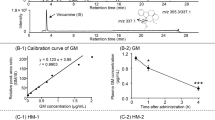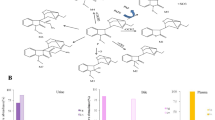Abstract
Background and Objectives
Methyl 3,4-dihydroxybenzoate (MDHB) has the potential to prevent neurodegenerative diseases (NDDs). The present work aims to reveal the pharmacokinetics and tissue distribution characteristics of MDHB.
Methods
The pharmacokinetics and tissue distribution of MDHB were analyzed using LC-MS/MS after a single intragastric administration (50 to 450 mg/kg) in mice, and samples were collected from five animals at specific time points.
Results
Pharmacokinetic parameters of MDHB following intragastric administrations were: the time to peak concentration (Tmax) ranged from 0.033 to 0.07 h, the peak concentration (Cmax) ranged from 12,379.158 to 109798.712 μg/l, the elimination half-life (t1/2z) ranged from 0.153 to 1.291 h, the area under the curve (AUC0–∞) ranged from 640.654 to 20,241.081 μg/l × h, the mean residence time (MRT0–∞) ranged from 0.071 to 0.206 h, the apparent volume of distribution (Vz/F) ranged from 17.538 to 45.244 l/kg, and the systemic clearance (Clz/F) ranged from 22.541 to 80.807 l/h/kg. The oral bioavailability of MDHB was 23%. The maximum MDHB content was detected in the stomach, and the minimum content was observed in the testes; the peak content in the brain was 15,666.93 ng/g.
Conclusions
The pharmacokinetic characteristics of MDHB include fast absorption, high systemic clearance, a short half-life and an oral bioavailability of 23%. Additionally, MDHB permeates the blood-brain barrier (BBB) and is rapidly distributed to all organs. The identification of the pharmacokinetics of MDHB following its oral administration will contribute to further preclinical and clinical studies of its effects.



Similar content being viewed by others
References
Alzheimer’s Association. Alzheimer’s disease facts and figures. Alzheimer’s Dement. 2017;13:325–73.
Elufioye TO, Berida TI, Habtemariam S. Plants-derived neuroprotective agents: cutting the cycle of cell death through multiple mechanisms. Evid Based Complement Altern Med. 2017. https://doi.org/10.1155/2017/3574012.
Kim GH, Kim JE, Rhie SJ, Yoon S. The role of oxidative stress in neurodegenerative diseases. Exp Neurobiol. 2015;24(4):325–40.
Kumar V, Sami N, Kashav T, Islam A, Ahmad F, Hassan MI. Protein aggregation and neurodegenerative diseases: from theory to therapy. Eur J Med Chem. 2016;124:1105–20.
Wang Y, Qin ZH. Molecular and cellular mechanisms of excitotoxic neuronal death. Apoptosis. 2010;15(11):1382–402.
Kempuraj D, Thangavel R, Selvakumar GP, Zaheer S, Ahmed ME, Raikwar SP, et al. Brain and peripheral atypical inflammatory mediators potentiate neuroinflammation and neurodegeneration. Front Cell Neurosci. 2017;11:216.
Zhang W, Cai L, Geng HJ, Su CF, Yan L, Wang JH, et al. Methyl 3,4-dihydroxybenzoate extends the lifespan of Caenorhabditis elegans, partly via W06A7.4 gene. Exp Gerontol. 2014;60:108–16.
Trippier PC, Jansen Labby K, Hawker DD, Mataka JJ, Silverman RB. Target- and mechanism-based therapeutics for neurodegenerative diseases: strength in numbers. J Med Chem. 2013;56(8):3121–47.
Bi DL, Wen L, Xiong W, Shen Y. Development of potential therapeutic targets of and approaches to Alzheimer disease. Chin J Pharmacol Toxicol. 2015;29(04):507–36.
Kazim SF, Iqbal K. Neurotrophic factor small-molecule mimetics mediated neuroregeneration and synaptic repair: emerging therapeutic modality for Alzheimer’s disease. Mol Neurodegener. 2016;11(1):50.
Xu WQ, Gong XJ, Zhou X, Zhao C, Chen HG. Chemiacal constituents and bioactivity of Kalimeris indica. China J Chin Mater Med. 2010;35(23):3172–4.
Ma L, Li JM, Chen YQ, Li Y, Guo XJ. Determination of 3, 4-dihydroxy methyl benzoate in Hedyotis diffusa Willd by HPLC. LishiZhen Med Mater Med Res. 2009;20(03):528–9.
Zhang Z, Zhou X, Zhou XW, Xu X, Liao MJ, Yan L, et al. Methyl 3,4-dihydroxybenzoate promotes neurite outgrowth of cortical neurons cultured in vitro. Neural Regen Res. 2012;7(13):971–7.
Zhang Z, Cai L, Zhou XW, Su C, Xiao F, Gao Q, et al. Methyl 3,4-dihydroxybenzoate promote rat cortical neurons survival and neurite outgrowth through the adenosine A2a receptor/PI3 K/Akt signaling pathway. NeuroReport. 2015;26(6):367–73.
Zhou XW, Zhang Z, Su CF. Methyl 3,4-dihydroxybenzoate protects primary cortical neurons against Aβ25–35-induced neurotoxicity through mitochondria pathway. J Neurosci Res. 2013;91:1215–25.
Zhou X, Su CF, Zhang Z, Wang CY, Luo JQ, Zhou XW, et al. Neuroprotective effects of methyl 3,4-dihydroxybenzoate against H2O2-induced apoptosis in RGC-5 cells. J Pharmacol Sci. 2014;125(1):51–8.
Cai L, Wang LF, Pan JP, Mi XN, Zhang Z, Geng HJ. Neuroprotective effects of methyl 3,4-dihydroxybenzoate against TBHP-induced oxidative damage in SH-SY5Y Cells. Molecule. 2016;21(8):1071.
Zhang J, Xu D, Ouyang H, Hu S, Li A, Luo H, et al. Neuroprotective effects of 3,4 dihydroxybenzoate in a mouse model of retinitis pigmentosa. Exp Eye Res. 2017;162:86–96.
Guidance for industry, bioanalytical method validation. US Food and Drug Administration. 2013. https://www.fda.gov/downloads/drugs/guidancecomplianceregulatoryinformation/guidances/ucm368107.pdf. Accessed 15 Dec 2017.
Zhong DF, Li G, Liu CX. Guidance on bioanalysis: method validation and analysis of study samples (draft). Drug Eval Res. 2011;34(06):409–15.
Guidance for non-clinical pharmacokinetics study. China Food and Drug Administration. 2014. http://www.sda.gov.cn/WS01/CL1616/101019.html. Accessed 15 Dec 2017.
Matuszewski BK, Constanzer ML, Chavez-Eng CM. Strategies for the assessment of matrix effect in quantitative bioanalytical methods based on HPLC-MS/MS. Anal Chem. 2003;75(13):3019–30.
Xu ZY. Studies on pharmacokinetic and metabolic mechanism of Timosaponin B-II. Shanghai: Second Military Medical University; 2013.
Hughes JH, Upton RN, Foster DJR. Comparison of non-compartmental and mixed effect modelling methods for establishing bioequivalence for the case of two compartment kinetics and censored concentrations. J Pharmacokinet Pharmacodyn. 2017;44(3):233–44.
Chen C, Xu L, Zheng QS. Study of the algorithm of elimination half-life time in pharmackinetics. Chin J Clin Pharmacol Ther. 2013;18(08):891–7.
Wang GJ. Pharmacokinetics. 1st ed. Beijing: Chemical Industry Press; 2005.
Cao YX. Discussion on apparent distribution volume in pharmacology textbooks. Negative. 2013;4(04):31–2.
Peters SA, Jones CR, Ungell AL, Hatley OJ. Predicting drug extraction in the human gut wall: assessing contributions from drug metabolizing enzymes and transporter proteins using preclinical models. Clin Pharmacokinet. 2016;55(6):673–96.
Aungst BJ. Optimizing oral bioavailability in drug discovery: an overview of design and testing strategies and formulation options. J Pharm Sci. 2017;106(4):921–9.
Lipinski CA, Lombardo F, Dominy BW, Feeney PJ. Experimental and computational approaches to estimate solubility and permeability in drug discovery and development settings. Adv Drug Deliv Rev. 2001;46(1–3):3–26.
Wu BJ, Kulkarni K, Basu S, Zhang SX, Hu M. First-pass metabolism via UDP-glucuronosyltransferase: a barrier to oral bioavailability of phenolics. J Pharm Sci. 2011;100(9):3655–81.
Jeon JS, Oh SJ, Lee JY, Ryu CS, Kim YM, Lee BH, et al. Metabolic characterization of meso-dihydroguaiaretic acid in liver microsomes and in mice. Food Chem Toxicol. 2015;76:94–102.
Alavijeh MS, Chishty M, Qaiser MZ, Palmer AM. Drug metabolism and pharmacokinetics, the blood-brain barrier, and central nervous system drug discovery. NeuroRx. 2005;2(4):554–71.
Gribkoff VK, Kaczmarek LK. The need for new approaches in CNS drug discovery: why drugs have failed, and what can be done to improve outcomes. Neuropharmacology. 2017;120:11–9.
Jin LW, Wei WF, Gao Y. Research progress in penetration mechanism of chemical constituents in chinese materia medica into blood-brain barrier and penetration enhancing methods. Chin Tradit Herb Drugs. 2013;44(15):2183–8.
Deng QY, Dong J. The research progress of chinese herb and its active ingredient through blood-brain barrier mechanism. Chin J Gerontol. 2011;31(18):3639–41.
Mikitsh JL, Chacko AM. Pathways for small molecule delivery to the central nervous system across the blood-brain barrier. Perspect Med Chem. 2014;6:11–24.
Jiang RG, Qi XR. Blood brain barrier model and central nervous system drug transport evaluation. Chin Pharm J. 2012;47(11):880–3.
Sanchez-Covarrubias L, Slosky LM, Thompson BJ, Davis TP, Ronaldson PT. Transporters at CNS barrier sites: obstacles or opportunities for drug delivery? Curr Pharm Des. 2014;20(10):1422–49.
Zhang DL, Zhu, Humphreys WG. Drug metabolism in drug design and development- basic concepts and practice, vol. 1. Beijing: People’s Military Medical Press; 2011.
Agundez JA, Jimenez-Jimenez FJ, Alonso-Navarro H, Garcia-Martin E. Drug and xenobiotic biotransformation in the blood-brain barrier: a neglected issue. Front Cell Neurosci. 2014;8:335.
Zhang ZQ, Sheng L, Li Y. Drug glucuronidation and disposition in brain. Acta Pharm Sin. 2016;51(11):1674–80.
Wang XY, Yan KJ, Ma XH, Li W, Chu Y, Guo JH, et al. Simultaneous determination and pharmacokinetic study of protocatechuic aldehyde and its major active metabolite protocatechuic acid in rat plasma by liquid chromatography-tandem mass spectrometry. J Chromatogr Sci. 2016;54(5):697–705.
Xu M, Fu G, Qiao X, Wu WY, Guo H, Liu AH, et al. HPLC method for comparative study on tissue distribution in rat after oral administration of salvianolic acid B and phenolic acids from Salvia miltiorrhiza. Biomed Chromatogr. 2007;21:1052–63.
Author information
Authors and Affiliations
Corresponding author
Ethics declarations
Funding
This work was supported by grants from the National Natural Science Foundation Committee of China (grant nos. 81473296, 81173037 and 81202519), the National Program on Key Basic Research Project (973 Program; no. 2011CB707500) and the Guangdong Provincial Department of Science and Technology (grant nos. 2012B050300018 and 2010B030700018).
Conflict of Interest
None of the authors have conflicts of interest to declare.
Ethical Approval
The animal experiments adhered to the “Jinan University Medical College Animal Use Ordinance” and were approved by the Ethics Committee of the Medical School of Jinan University.
Electronic supplementary material
Below is the link to the electronic supplementary material.
Rights and permissions
About this article
Cite this article
Wang, J.H., Hu, S.H., Su, J.Y. et al. Determination of the Pharmacokinetics and Tissue Distribution of Methyl 3,4-Dihydroxybenzoate (MDHB) in Mice Using Liquid Chromatography-Tandem Mass Spectrometry. Eur J Drug Metab Pharmacokinet 44, 237–249 (2019). https://doi.org/10.1007/s13318-018-0512-8
Published:
Issue Date:
DOI: https://doi.org/10.1007/s13318-018-0512-8




